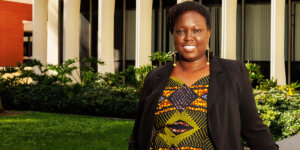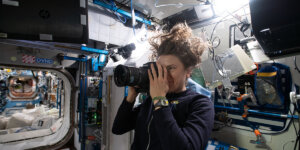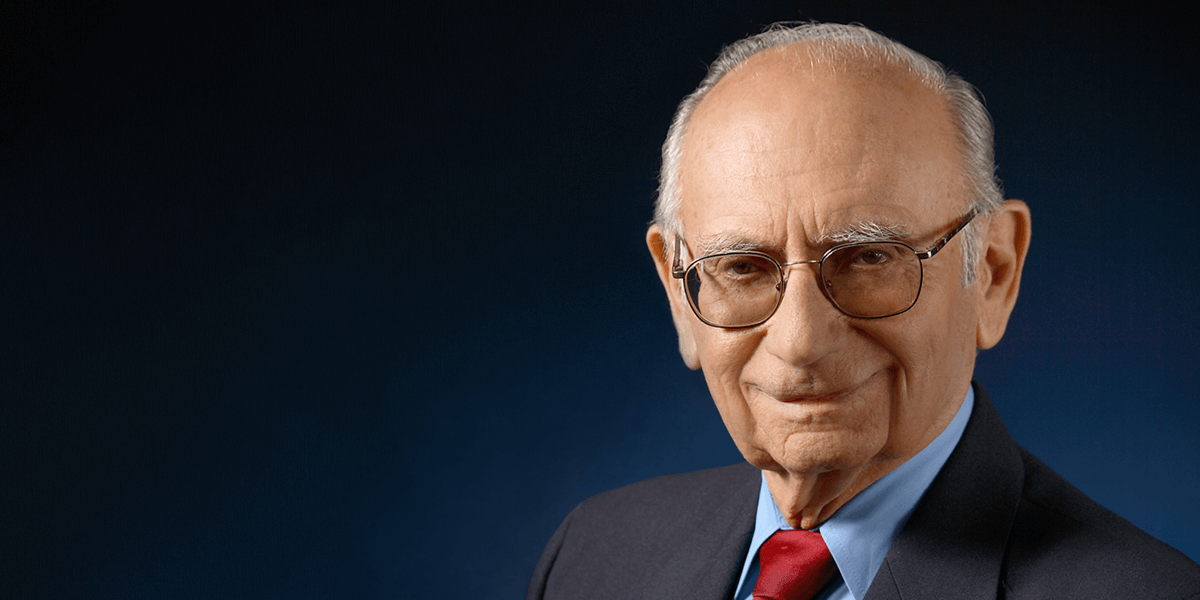
Bekey, professor emeritus of computer science, electrical engineering and biomedical engineering, is considered one of the pioneers of modern robotics (PHOTO CREDIT: USC Viterbi)
George A. Bekey, the renowned American roboticist and Professor Emeritus of Computer Science, Electrical Engineering, and Biomedical Engineering at the USC Viterbi School of Engineering, has passed away. He was 96.
A pioneer of modern robotics, he was inducted as a member of the National Academy of Engineering in 1989. As a teacher and a mentor, he was not above leaping on his desk — well into his sixties — to illustrate a point about robot locomotion. And, over the course of his 40-year career at the USC Viterbi School of Engineering, Bekey had an enviable track record in launching many of the school’s most noteworthy departments and initiatives.
As a USC researcher, Bekey was one of the creators of the “Phony Pony,” the world’s first four-legged walking machine in 1968 and co-developed the first humanoid, five-fingered robotic hand in 1977, the first able to give a true handshake.
“The USC Viterbi School has risen to global prominence largely because we are standing on the shoulders of giants like George,” said Yannis Yortsos, dean of the USC Viterbi School of Engineering. “For decades, George Bekey has been one of USC’s and the nation’s greatest intellectual assets.”
This year, for example, witnessed the creation of the USC School of Advanced Computing (SAC), a unit of the USC Viterbi School of Engineering, and the university’s 23rd school — led by Professor Gaurav Sukhatme, Ph.D. CS ’97, the school’s inaugural director and a proud member of the “Bekey tribe,” a group of 38 former Ph.D. students.
But the origins of the new school can be traced decades earlier.
According to “A Remarkable Trajectory,” his USC Viterbi history book, Bekey secured the first significant computer in the school’s history.
In the mid-1960s, over lunch with IBM, Bekey signed a “letter of intent” on a napkin to secure a new IBM 360-44 mainframe computer. This million-dollar machine built upon his unique hybrid digital-analog computers in the System Simulation Laboratory.
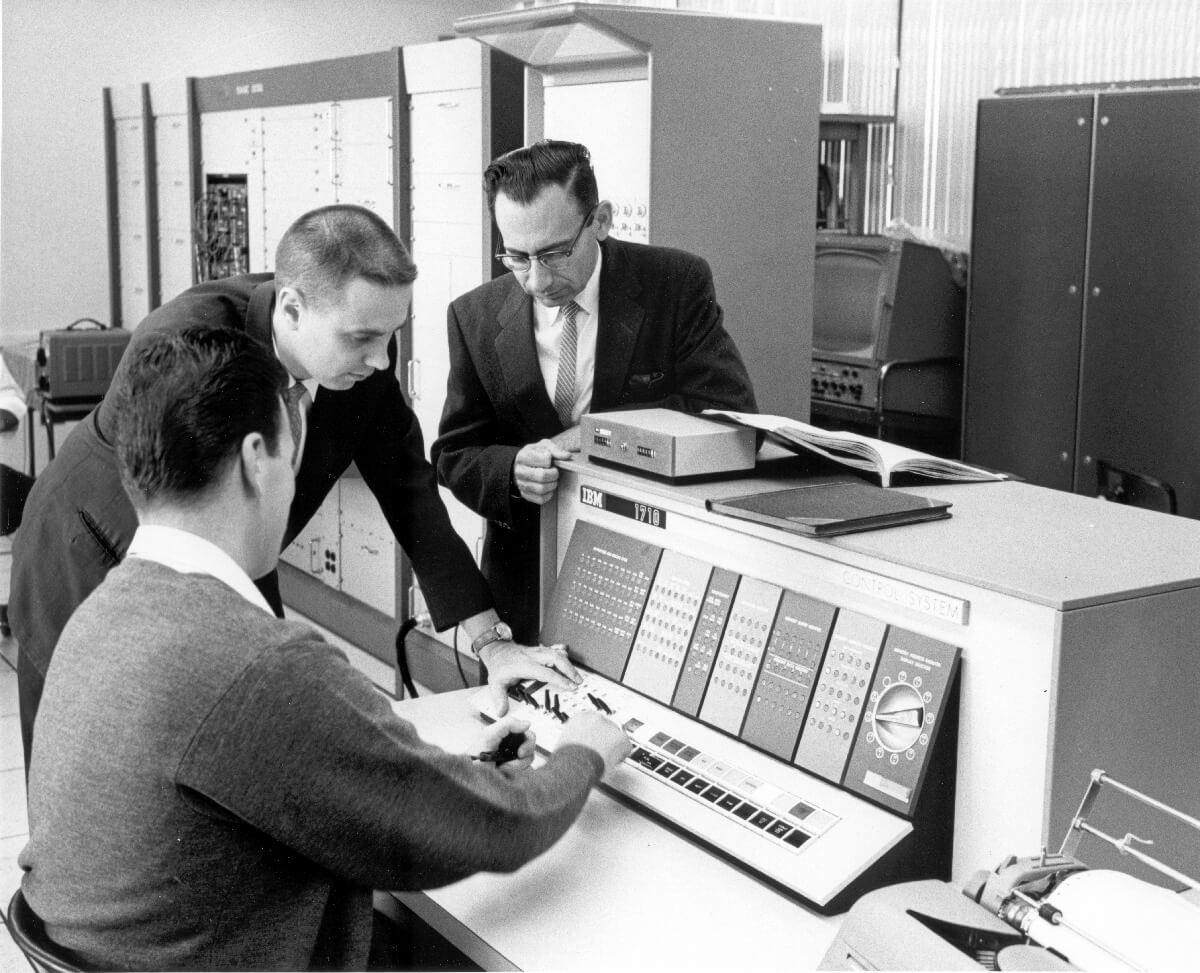
George Bekey (standing right) and Robert McGhee (middle) in the USC System Simulation Laboratory in the 1960s.
One of his other signature contributions to USC was his role in the creation of the USC Information Sciences Institute (ISI), arguably USC’s crown jewel research institute over the last 50 years.
In 1972, Keith Uncapher, the future ISI founder and executive director, was looking for a new home. Having left the Rand Corporation due to drastic budget cuts, Uncapher envisioned a new kind of entity: a semi-autonomous computing institute affiliated with a university. He had already been promised DARPA funding to create and lead a center to design, develop and run the early internet. Uncapher had to move fast, and he reached out to the one person he knew at USC: George Bekey, who he had met in the 1960s during experiments on the JOHNNIAC computer.
Bekey arranged a series of meetings. They culminated with then dean and USC executive vice president Zohrab Kaprielian’s decision to move forward. USC made the decision in an astonishing five days.
Joining USC in 1962, Bekey had an indelible impact on the modern-day USC Viterbi School of Engineering.
In addition to pioneering USC robotics research (which he led until the late 1990s), he also helped to establish the recently named Alfred Mann Department of Biomedical Engineering, the source of such breakthroughs as the world’s first artificial retina to restore sight to the blind and a brain implant to restore long term memory to sufferers of Alzheimer’s or dementia.
Bekey’s illustrious career — which spanned over five decades — integrated multiple subjects such as computer science, electrical engineering, biomedical engineering and biology. A pioneer in several fields, he was a longtime proponent of interdisciplinary work for its potential to improve research and hasten scientific breakthroughs. His work significantly advanced the fields of robotics and automation, while influencing humanoid development, human-robot interaction and coordination and control of multiple robots.
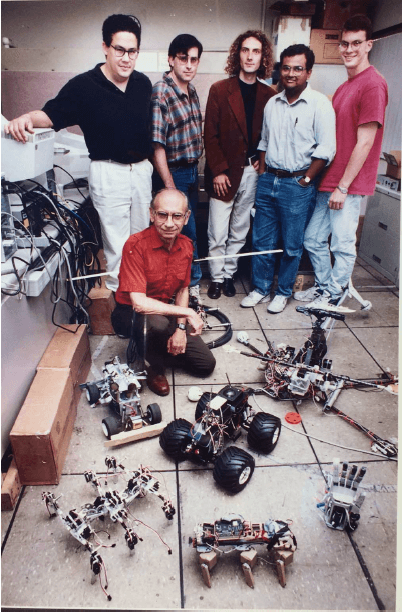
Professor George Bekey (kneeling) with members of the “Bekey tribe.”
But it was his impact on students that may be among his greatest legacies. Many of these were vividly recalled in a 2022 USC Viterbi News article entitled “Bekey Changed My Life.”
Ayanna Howard, Ph.D. EE ’99, now serves as dean of the College of Engineering at Ohio State University. “During one of my first graduate robotics classes at USC, Dr. Bekey began to discuss robot locomotion and the gait patterns of animals,” said Howard. “At one point, he jumped onto the table and, with great enthusiasm, simulated the walking pattern for a quadrupedal robot mimicking cat locomotion. I was hooked. Here was this famous, larger-than-life leader in robotics, and he cared enough, without hesitation, to inspire us using nontraditional methods.”
Another former student turned dean is Arvin Agah, Ph.D. CS ’94. When asked to provide some insight into his relationship with his adviser, Agah, then dean of engineering at the University of Kansas, went back and looked at his dissertation. “I had not looked at my dissertation in some time, but when I did, I opened the acknowledgment section and saw that I had written, ‘There is no fact in my professional and academic life that I am prouder of than my association with my advisor, Professor George A. Bekey,’” he said. “It is amazing that after nearly a quarter of a century, that statement still holds true.”
Sukhatme, who leads the new USC School of Advanced Computing, as well as serving as the USC Viterbi executive vice dean of engineering, said: “I could not have asked for a kinder or wiser mentor, and in running my own research group I have from time to time asked myself, ‘WWGD?’ (What would George do?).”
“I cared about my students as people,” Bekey said in 2021. “I looked at them as fellow seekers in the research journey. They were partners in the search to make meaningful discoveries.”
Bekey also played a key role in changing the face of USC engineering. Alice Parker, now Professor Emerita of Electrical and Computer Engineering, was hired by Bekey in 1980. She was the school’s second female hire. When he turned over his robotics lab, he transitioned to Professor Maja Matarić, who he had recruited early in her career.
Matarić, who received the 2009 Presidential Award for Excellence in Science, Mathematics, and Engineering Mentoring from President Barack Obama, said: “When I was finishing my Ph.D. in 1994, George Bekey invited me to give a talk at USC. Those were the lean years, and there was no hiring, so it was not an interview. But George was looking ahead, as always. He wanted to show off the department, colleagues and students. He used his discretionary funds to put me up in a little motel on the beach, so that I would really appreciate L.A. It worked — I was enchanted! And so, three years later, when he heard that I was looking for a position in California, he reached out to me and reminded me how great my visit was. This time, for a real interview, I stayed on campus and had the meeting with the dean and department chair, but it was George who had already persuaded me, years earlier.”
Parker, who has worked on developing an artificial brain, said: “Being mentored by George Bekey was one of the highlights of my career. He could provide guidance and innovate with subtle suggestions, and sometimes years later, it was clear that George Bekey caused something momentous to happen. He was humble and always focused on causes that had meaning. I owe him everything for his contributions to my career and his guidance will be deeply missed.”
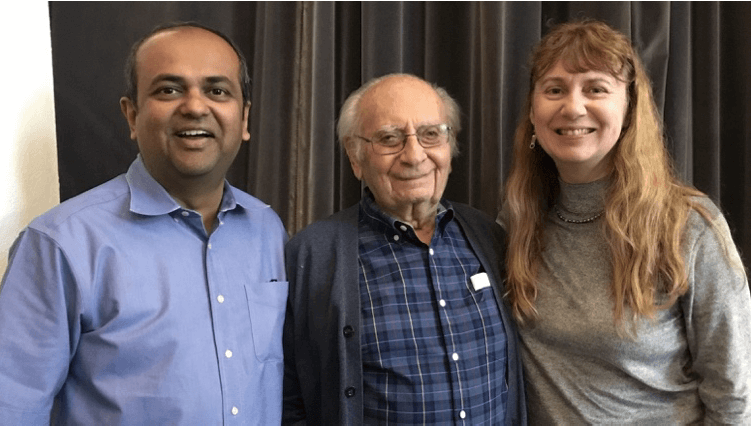
Bekey with USC Viterbi professors Gaurav Sukhatme and Maja Matarić (PHOTO CREDIT: Gaurav Sukhatme)
Born in Bratislava, Slovakia (then Czechoslovakia) in 1928 to an engineer father and chemist mother, Bekey’s family moved to Prague when he was a few years old. In 1938, his secular Jewish family fled the Nazi invasion on the last train out of Prague. Because Jews weren’t permitted to leave the country, Bekey’s father bribed an official for train papers that turned out to be forgeries. They escaped near-certain death only because the conductor missed their row.
The family settled in La Paz, Bolivia, where George Bekey and his younger brother, Ivan, attended a school run by American Methodists. Bekey’s father immediately launched his own business despite speaking no Spanish, moving from fixing sewing machine motors to becoming the go-to caretaker of the nation’s power plants. After five years, the family emigrated to join surviving relatives in California. Despite his limited, heavily Spanish-accented English, Bekey quickly joined the high school debating team – characteristic of the optimism, curiosity and creative problem-solving for which he later became known.
Bekey graduated from the University of California, Berkeley in 1950 with a bachelor’s in electrical engineering and received his master’s in 1952 and Ph.D. in 1962, both in engineering, at the University of California, Los Angeles.
A prolific writer, Bekey authored or co-authored more than a dozen books, including his most recent on “Robot Ethics” – of which he was an early proponent – and about 250 professional articles. His book on the history of USC engineering, “A Remarkable Trajectory,” is the most comprehensive account of the school’s history until 2014.
George was an IEEE Life Fellow and a member of the U.S. National Academy of Engineering. He was the founding editor of the IEEE Transactions on Robotics and Automation and the journal Autonomous Robots, a founding member of the IEEE Robotics and Automation Society and a recipient of the IEEE Third Millennium Medal, the IEEE Robotics and Automation Award and the IEEE Robotics and Automation Distinguished Service Award.
He received the USC Presidential Medallion in 2000.
Said Sukhatme: “Professor Bekey was a progressive thinker. He gave his students the encouragement and freedom to dream big. He was a formative figure in the rise of the Viterbi School to its current stature and the growth of robotics as a field of research.”
He is survived by his son, Ronald (Ramona Holmes), daughter, Michelle (Ron Fryer), brother, Ivan (Marlene), and cousins, nephews and nieces. According to the family, in keeping with Bekey’s deep appreciation of the natural world, any donations in his name can be made to nonprofit forester TreePeople of Los Angeles.
— With additional contributions by Michelle Bekey
Published on October 18th, 2024
Last updated on October 18th, 2024





